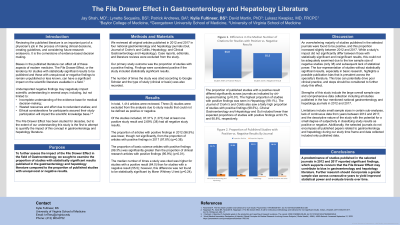Back


Poster Session E - Tuesday Afternoon
Category: Practice Management
E0626 - The File Drawer Effect in the Gastroenterology and Hepatology Literature
Tuesday, October 25, 2022
3:00 PM – 5:00 PM ET
Location: Crown Ballroom

Has Audio

Kylie Fultineer, BS
University of Virginia
Charlottesville, VA
Presenting Author(s)
Jay S. Shah, MD1, Lynette Sequeira, BS2, Patrick Andrews, BA3, Kylie Fultineer, BS3, David Martin, PhD3, Lukasz Kwapisz, MD1
1Baylor College of Medicine, Houston, TX; 2Georgetown University, Richmond, VA; 3University of Virginia, Charlottesville, VA
Introduction: The File Drawer Effect, or the tendency for studies with statistically significant results to be published and those with unequivocal or negative findings to remain unpublished or less known, can have a significant impact on the scientific literature available in a field. We sought to examine the proportion of studies with statistically significant results published in the gastroenterology and hepatology literature.
Methods: We reviewed all original articles published in 2012 and 2017 in four national gastroenterology and hepatology journals (Gut, Journal of Crohn’s and Colitis, Hepatology, and Clinical Gastroenterology and Hepatology). Our primary study outcome was the proportion of studies with a statistically significant finding. The number of times the study was cited according to Google Scholar was recorded and used as a measure of a study’s impact. The type of study (clinical or basic) was also recorded.
Results: In total, 1,414 articles were reviewed and 3 were excluded due to unclear study results. Of the studies included, 97.31% (1,373) had at least one positive study result and 2.69% (28) had all negative study results. The proportion of articles with positive findings in 2012 (96.9%) was lower, though not significantly, from the proportion of articles with positive findings in 2017 (97.8%) (p< .38). The proportion of clinical science articles with positive findings (99.3%) was significantly greater than the proportion of basic research articles with positive findings (95.9%) (p< .01). The difference between the median number of times a study was cited and whether the study had a positive or negative result was not found to be statistically significant (p=.26)
Discussion: An overwhelming majority of studies published in the selected journals were found to be positive, and this proportion increased slightly between 2012 and 2017. While a study’s impact did not significantly differ between those with statistically significant and insignificant results, this could not be adequately examined due to the low sample size of negative studies (only 28) and subsequent lack of statistical power. The low representation of studies without statistically significant results, especially in clinical research, highlights a possible publication bias that is prevalent across the specialty’s literature. This bias can potentially drive poor clinical practice, and steps should be considered to further study this effect.
Disclosures:
Jay S. Shah, MD1, Lynette Sequeira, BS2, Patrick Andrews, BA3, Kylie Fultineer, BS3, David Martin, PhD3, Lukasz Kwapisz, MD1. E0626 - The File Drawer Effect in the Gastroenterology and Hepatology Literature, ACG 2022 Annual Scientific Meeting Abstracts. Charlotte, NC: American College of Gastroenterology.
1Baylor College of Medicine, Houston, TX; 2Georgetown University, Richmond, VA; 3University of Virginia, Charlottesville, VA
Introduction: The File Drawer Effect, or the tendency for studies with statistically significant results to be published and those with unequivocal or negative findings to remain unpublished or less known, can have a significant impact on the scientific literature available in a field. We sought to examine the proportion of studies with statistically significant results published in the gastroenterology and hepatology literature.
Methods: We reviewed all original articles published in 2012 and 2017 in four national gastroenterology and hepatology journals (Gut, Journal of Crohn’s and Colitis, Hepatology, and Clinical Gastroenterology and Hepatology). Our primary study outcome was the proportion of studies with a statistically significant finding. The number of times the study was cited according to Google Scholar was recorded and used as a measure of a study’s impact. The type of study (clinical or basic) was also recorded.
Results: In total, 1,414 articles were reviewed and 3 were excluded due to unclear study results. Of the studies included, 97.31% (1,373) had at least one positive study result and 2.69% (28) had all negative study results. The proportion of articles with positive findings in 2012 (96.9%) was lower, though not significantly, from the proportion of articles with positive findings in 2017 (97.8%) (p< .38). The proportion of clinical science articles with positive findings (99.3%) was significantly greater than the proportion of basic research articles with positive findings (95.9%) (p< .01). The difference between the median number of times a study was cited and whether the study had a positive or negative result was not found to be statistically significant (p=.26)
Discussion: An overwhelming majority of studies published in the selected journals were found to be positive, and this proportion increased slightly between 2012 and 2017. While a study’s impact did not significantly differ between those with statistically significant and insignificant results, this could not be adequately examined due to the low sample size of negative studies (only 28) and subsequent lack of statistical power. The low representation of studies without statistically significant results, especially in clinical research, highlights a possible publication bias that is prevalent across the specialty’s literature. This bias can potentially drive poor clinical practice, and steps should be considered to further study this effect.
Disclosures:
Jay Shah indicated no relevant financial relationships.
Lynette Sequeira indicated no relevant financial relationships.
Patrick Andrews indicated no relevant financial relationships.
Kylie Fultineer indicated no relevant financial relationships.
David Martin indicated no relevant financial relationships.
Lukasz Kwapisz indicated no relevant financial relationships.
Jay S. Shah, MD1, Lynette Sequeira, BS2, Patrick Andrews, BA3, Kylie Fultineer, BS3, David Martin, PhD3, Lukasz Kwapisz, MD1. E0626 - The File Drawer Effect in the Gastroenterology and Hepatology Literature, ACG 2022 Annual Scientific Meeting Abstracts. Charlotte, NC: American College of Gastroenterology.
